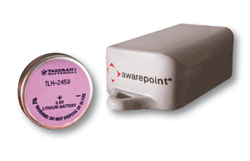Withstanding the heat of autoclaves is a must
BY SOL JACOBS
Tadiran Batteries
Port Washington, NY
http://www.tadiranbat.com
The demand for more efficient data capture and seamless information management has spurred a steady growth in wireless radio frequency identification (RFID) real-time location systems (RTLS) well beyond their initial manufacturing and distribution roots. these battery-powered systems are now found in other specialized industries such as the medical industry where cost containment and other dynamics have prompted design engineers into new modes of thought and innovation.
Driven largely by regulations and legal liability concerns, hospitals and other healthcare facilities are embracing new technologies that raise efficiency and improve workflow especially in the area of data capture and asset tracking. Active RFID systems represent an ideal solution to this based upon the flexibility and immediate workability.
Today, many medical staff members are trained in their use of battery-powered RFID asset tracking devices to monitor portable medical equipment. This includes wheelchairs, gurneys, IV pumps, and pulse oximeters. RFID asset tags are also being utilized to monitor the whereabouts of patients and hospital personnel, providing instant access to vital patient information, as well as permanently archived time-stamped records to verify and monitor physical movement and location, visits by attending doctors and nurses. Asset tracking is also used to monitor and record surgical and therapeutic procedures and diagnostic tests, as well as the dispensing of pharmaceutical drugs and medications.
To capitalize on the enormous growth potential for medical RFID applications, designers must understand inherent technical challenges involving power management solutions and the harsh environment to which they will be exposed, such as high temperatures associated with autoclave and liquid sterilization procedures. This was clearly on the minds of the product design engineers at Awarepoint when they created the Awarepoint T2S asset tag, their newest generation of self-contained, battery-operated active RFID asset tags.
Awarepoint surveyed its customers and identified a hot-button problem; battery autoclavability, or the inability of the battery packs to withstand extreme steam heat used in sterilizing reusable assets.

Fig. 1. RFID asset tags for medical applications need to handle power management solutions and harsh environments.
Earlier generations of active RFID asset tags used batteries that could not take the heat, which in many cases is as high as 135°C. As a result, medical equipment that requires steam sterilization was unable to benefit from active RFID technologies. This limitation partially defeats the reason for using RFID technology: to provide fully automated and verifiable real-time 24-hour monitoring and reporting capabilities.
To overcome these major technical challenges, Awarepoint sought out the ideal battery solution as a critical first step in designing a wireless active RFID asset tag that could be sterilized in autoclaves or liquid sterilization cycles.
After conducting a thorough review of all available battery technologies, the design team selected the TLH-2450 coin-size lithium thionyl chloride batteries from Tadiran to provide primary power. It proved in environmental tests that it could withstand the 135F heat associated with standard autoclave cycles.
The tag is also designed to work continuously for 500 steam-sterilization cycles, or one year on the original battery, which presents added convenience and lower long-term maintenance expense. These compact 3.6-V cells feature 0.55-Ah capacity at 0.5 mA, and maximum service life of up to 20 years. The cells are also UL recognized and considered nonhazardous when shipped.
The TLH-2450 cells helped fuel several productivity improvements for those using the asset tags. The batteries provide the power necessary to support continuous remote monitoring throughout the sterilization process. Searching for equipment in a hospital’s sterile processing department can be time consuming and often frustrating.
However, since Awarepoint’s T2S active RFID asset tags can be sterilized while remaining attached to the medical device, hospital staff can immediately locate equipment in the sterile processing department and determine its clean/dirty status with the click of a button. The tags will also alert medical staff if a device is returned to service without proper sterilization.
The battery and the asset tag exemplify an increasingly popular collaborative mindset among manufacturers today, one that often raises the technological bar to a higher performance standard.
For more on batteries, visit http://www2.electronicproducts.com/Power.aspx.
Advertisement
Learn more about Tadiran





